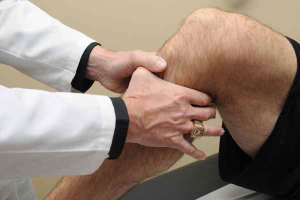The anterior drawer test is more of a historical test rather than an actual useful clinical test. It was originally felt that it was positive when there was an ACL tear, however the amount of increased translation at 90° with an isolated ACL tear compared to the contralateral side is quite minimal. In fact, the amount of increased anterior translation is the least at 90° compared to all knee flexion angles between 0°-90°. The anterior drawer may be positive in patients who have a lack of the posterior horn of the medial meniscus and an ACL tear. Thus, the anterior drawer may be more useful in patients where there is a concern of significantly increased anterior translation on their Lachman’s test and it will help to assess for the possible lack of integrity of the posterior horn of the medial meniscus.
The anterior drawer test is performed with the knee flexed to between 80°-90 °, and the knee completely relaxed. The foot must be stabilized by either sitting on it or placing ones hand, or an assistant’s hand, against it. The tibia is then translated anteriorly in neutral rotation, with a firm and gentle grip. A gentle to-and-fro motion should be performed to determine if there is increased anterior translation compared to the normal contralateral side.

